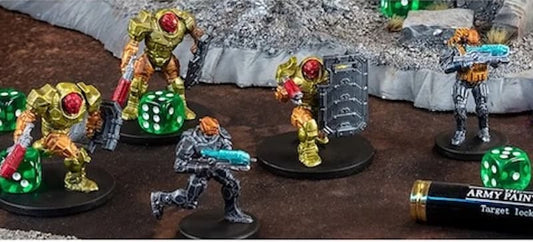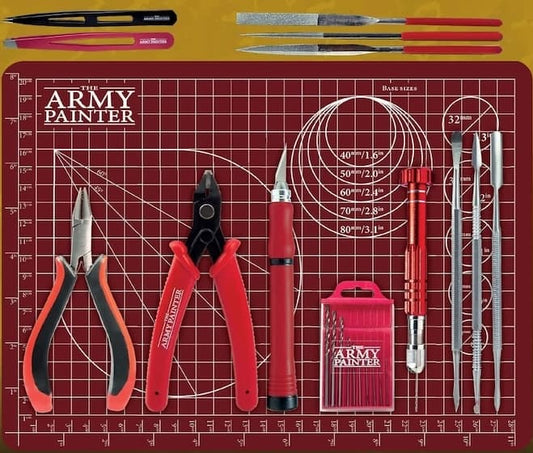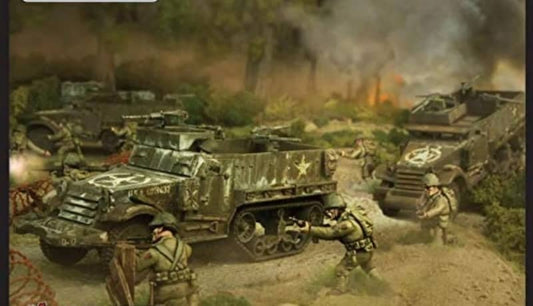Tabletop wargames spread across a variety of different combat spaces. Some battles occur over flat, open terrain where hills , woods, and other obstacles barely impede line of sight. Other games take place on densely packed city streets or in the close confines of a jungle. No matter what type of game you're playing, though, there are really only three types of terrain that you need to be aware of. And, each kind of terrain changes the way that you play the game in a very particular way.
I'll note that it is impossible to cover every aspect of terrain in a single article.
As with any battle, games vary in such scope that it is unlikely that any two wargamers will have the same experience with a given type of terrain. These are simply generalities that should give you a good idea of what to expect when playing on different kinds of terrain.

Basic Principles of Wargaming Terrain
Before we dive in, let's quickly go over a few key principles that will help you understand how terrain can affect your game.
- Line of Sight (LOS) Blocking Terrain
- Movement Hindering Terrain
- Combat Cover (e.g., Ballistic or Close Combat Mitigation)
- Interactive Terrain
The first is that line of sight (LOS) is everything in wargaming. LOS is what allows you to target an enemy unit with your forces, and it also determines whether or not you can be targeted in return. In general, the more open the terrain, the easier it will be for you to spot and target enemy units. Conversely, dense terrain makes it harder for you to see and be seen by the enemy.

Another key principle is that different types of terrain offer different degrees of cover. Cover can be anything from a large rock to an entire forest, and it will help to protect those units behind it. Movement can also be affected by terrain, with dense terrain often slowing down movement and open terrain making it easier to move large numbers of troops across the battlefield quickly.
Finally, many wargames will have unique terrain rules that allow you to interact with the environment in ways that go beyond simple visibility and movement. This can include things like controlling or claiming specific pieces of terrain for your side, triggering special events when moving through certain types of terrain, or even using the surrounding environment to your advantage by building gates, walls, or other obstacles.
With all of that in mind, let's take a look at the three main types of terrain you'll encounter on the wargaming table.
3 Types of Terrain Styles Every Wargamer Should Know About
-
Flat or Open Terrain
When most people think of wargaming terrain, they tend to picture an open battlefield with relatively flat terrain. This is one of the most common types of battle space in many games and it tends to be easy to move around on and see through.

Flat terrain usually means that line of sight will not be a major issue, as long as your units have a clear line of sight to their targets. It also makes it easy for you to move large numbers of troops across the battlefield, though this can be mitigated somewhat by placing obstacles and buildings along the way.

I'll note here that whatever your game type, open fields of battle are a great way for newcomers to wargames to start learning the basics of gameplay. Without the need to understand the intricacies of cover, obstacles and blocking terrain features, it is easier to focus on the core mechanics of moving, attacking and defending with your troops.
Note that you can intersperse dense terrain across an open field to add variety to how your battle plays out (more about this below). This is often referred to broken, or rough terrain, wherein you'll see things like hills, small forests and the like within an open space. This creates a unique mix of open and closed terrain that can add some depth to your battles.

Cover is also not usually much of an issue on flat terrain, which means that most units will be exposed to enemy fire. By using careful positioning and movement, though, you may be able to mitigate some of this risk with your troops.

Finally, flat terrain often comes with its own set of special rules that can play a factor in how battles on that type of terrain pan out. For example, lines of trenches and wire may be used to channel the enemy's movement or prevent them from using certain types of attacks. Gates and fortifications can be used to protect a crucial piece of terrain or slow down an enemy attack. You'll need to learn these special rules before you can use them successfully in your games.
2. Dense Terrain
The other extreme from flat, open terrain is dense terrain, which is defined as any piece of terrain that makes it difficult for troops to move through or see across. This can include things like forests, swamps, and urban areas.
Dense terrain often offers a good deal of cover for your troops, making them harder for the enemy to target. It can also increase the chance of your troops getting hit by friendly fire, but this can be offset somewhat by simply increasing the number of units you have on the field.
Dense terrain can also make it difficult for your troops to see the enemy, giving them a chance to set ambushes or otherwise prepare for your arrival. This can be mitigated by using scouts or other units that have special rules allowing them to see through dense terrain.

Dense terrain can also block line of sight, making it difficult to attack the enemy without moving into their line of sight. This can leave you vulnerable, so it is important to make sure that any units attacking from dense terrain have a clear line of sight to the enemy.
Movement within dense terrain will slow down and make it harder to maneuver large numbers of troops across the battlefield. This means that you and other players will need to plan ahead for any movement through this type of terrain, or else you may be caught off guard by the enemy. The speed or agility of units also becomes a significant factor with dense terrain features in your battle space.

Dense terrain often comes with its own special rules that will need to be learned before the battle begins. This can include things like hidden units being revealed when moving through certain types of terrain, areas being cordoned off where one unit cannot move through another, or even special movement rules for units that are moving across difficult terrain.
A game that uses dense terrain will often take a lot longer to play. It may take more turns/rounds in a game to resolve a particular conflict. Certainly, as mentioned, there are more rules players will have to contend with on densely terrain populated tabletop, such as the need for specific unit types to cross certain types of terrain (e.g., infantry and mounted troops can traverse forests, but cavalry may not). Be aware of this extra time-to-complete-a-game when you consider choosing how or what terrain you want to play with (if it is necessary at all).
3. Unique Terrain
Many wargames also include different types of unique terrain, which is any type of terrain that has its own specific effects on the game. This can include things like rivers, mountains, and other large pieces of terrain that have a major impact on the battle.

Since each game will have its own unique pieces of terrain, it's important to learn what they are and how they work before the game begins. For example, a river might only allow certain units to cross over it, while mountains may prevent troops from moving across them at all. These kinds of terrain features will help to shape the battle, but they also require you to pay special attention to them as things develop.
In a science fiction or fantasy type game, e.g., Warhammer 40k or Age of Sigmar, there are pieces of terrain that grant nearby units special effects or powers. There might be a "Webway Portal" that allows Daemons to enter the battlefield, or a "Teleporter" that can instantly move troops across the battlefield. These are just a few examples, but there are many more out there. I could write articles and articles about all sorts of unique pieces of static terrain features that could influence the battlefield.

If you're playing a wargame that uses unique terrain, it's important to be aware of how those pieces of terrain might impact the battle. Learn the rules for each piece, and keep an eye out for them as the game develops. You may even want to create your own custom pieces of terrain that can be used in your games. Overall, the key thing to remember is that unique terrain can have a major influence on how your game plays out, so it's essential to be aware of and understand how it works before you begin.
Recommended Wargaming Terrain Kits
You can make your own terrain or buy kits. Making terrain is part of the wargaming hobby, but it can be time-consuming. If you don't have the time or patience to make your own, there are plenty of great options available for purchase.
RELATED: 3 WAYS TO MAKE DIY WARGAMING TERRAIN
Here are three recommended terrain kits and accessories for helping you create different types of tabletop landscapes for your wargames:


You get XPS foam for building walls, floors, and other structures that can be put together in any way you want. Use the included hot wire cutter (or check out these other hot wire foam cutters) for the best construction experience. You'll also get hobby paint along with plenty of accessories to add some flavor to your game. If you're looking to expand your model painting hobby, check out our highly popular Army Painter Mega Selection Paint set.

These recommendations aren't all encompassing. You can find a lot of terrain options here at Wargames Delivered. Check out our terrain kits and accessories for turning your tabletop into a battlefield. With the right terrain, you'll be able to create an immersive and realistic battlefield that your troops will love fighting over.
Conclusion
As you can see from these tips, there are many different factors to consider when it comes to choosing the right terrain for your wargames. By understanding how terrain works and what types of effects it can have on the game, you'll be able to make better decisions about where to place your troops and how to maneuver them around the battlefield.
With enough practice, you'll be able to use terrain to your advantage and come out victorious in any battle. Whether you are playing a historical game or something more fantastical, having the right terrain is essential. Choose one of these kits today to get started on creating your own wargaming terrain and start planning your next battle!
Are you a wargamer looking to add variety and spice to your tabletop? Want more realism or interaction within environmental factors in your gameplay? Then be sure to check out the terrain kit options from Wargames Delivered.
Happy wargaming!
You may also like our other Collections: Gamemaster Terrain Kits, Diorama & Terrain Building Kits, The Army Painter Game Master Collection, Glue
For Historical Wargames, you might like our Warlord Games Pike & Shotte
Also check out The Army Painter - Battlefields Basing Set! or The Army Painter - GameMaster: Wilderness & Woodlands Terrain Kit!



